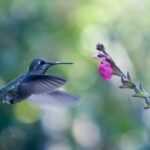Great spotted kiwis, apteryx hasstii, are the largest species of kiwi, although that isn’t saying much as all kiwis are small. They measure 17.7 to 19.6 inches (45 to 50 centimeters) tall and weigh 5.2 to 7.2 pounds (2.4 to 3.3 kilograms). Female great spotted kiwis are slightly larger than males. They are grayish brown, with some white thrown in as well. Like all kiwis, they are flightless birds with feathers that look like fur. Unlike most birds, great spotted kiwis have poor eyesight, but an excellent sense of smell.
Great spotted kiwis can be found exclusively in 3 discreet areas of New Zealand. They will inhabit a variety of areas such as hardwood forests, dry, alluvial podocarp, tussock grasslands and damp, mossy beech forests. They are able to move almost silently throughout their environment thanks to fleshy footpads located on the bottom of their large feet. Great spotted kiwis may have up to 100 different excavated burrows within their territory. However, unlike other kiwis, they will construct dens with tunnels up to several meters in length and that contain more than one exit. They are very territorial and will sometimes fight off intruders with their powerful legs and feet.
The diet of great spotted kiwis consists of earthworms, beetles, cicadas, spiders, caterpillars, crickets, flies, snails, slugs, berries and seeds. They use their long, slender beak to capture their food with ease. They are nocturnal, meaning that they hunt and do most of their activities at night and rest during the day. Predators that great spotted kiwis need to look out for are mainly mammalian creatures that are not native to New Zealand.
Mating for great spotted kiwis takes place mostly in the spring. Males and females will form pairs that can stay together for 2 to 3 mating seasons, or sometimes even for life. Females will lay 1 egg and both parents will take turns incubating it for anywhere from 70 to 85 days. The males will incubate during the day, and females will share in incubating during the night so that the males can go out and hunt for a few hours. The young kiwi will hatch fully feathered, unlike most birds. After 10 days, the chick will start to hunt without its parents, but still come back for about 3 to 4 weeks. For the first 6 weeks of its life, the chick may feed during the day, but it will eventually begin hunting exclusively at night. If the chick can make it to adulthood, it may live to be 30 to 40 years old.
Great spotted kiwis are a threatened species (as are all other kiwis). Deforestation, which leads to habitat loss, and predation by non-native creatures are the greatest threats to these flightless birds. Thankfully, kiwis are now protected as they are the national symbol of New Zealand. With efforts like this, kiwi populations everywhere will hopefully begin to benefit. After all, such a unique species of bird deserves to live and prosper in its native land for many years to come.
Resources:
“Great Spotted Kiwi (Apteryx Haastii)” 13 December 2010
“Great Spotted Kiwi” 13 December 2010




